Presented at the Tribeca Film Festival as part of their Immersive Lineup and now in competition at the Venice Film Festival, “The Severance Theory: Welcome to Respite” is a virtual reality production that allows you to join a theatrical experience about the powerful topic of Dissociative Identity Disorder.
The Severance Theory: Welcome to Respite is the kind of work you tend to mention when you want your friends and family to understand why you love XR so much.
Developed by Lyndsie Scoggin and Braden Roy and produced as a joint production between CoAct Productions and Ferryman Collective, Welcome to Respite is a theatrical experience performed live by an incredible group of actors. It is the first of four episodes that put viewers in the role of Alex and have them confront the childhood memories that led the character to develop dissociative identity disorder (DID).
As you slowly unravel Alex’s story and rediscover the origins of the trauma they have faced, you encounter their alternate personalities and the monster that populates their childhood: a visual representation of a psychological disorder that is touching and at the same time very frightening. This representation slips into you with a subtle disquiet that reaches its peak in the final scene with its slightly horror-like tinge. I physically tried to hide inside my headset at that moment, because certain fears, no matter how old you are, are always there… literally living inside a closet.

Welcome to Respite attempts to portray psychological dynamics that may be unfamiliar to most of us, and succeeds in doing so because it places them in the familiar context of everyday memories and the way we perceive them in real life: as generally vague and indistinct forms, but where some details shine brighter than others – as in Welcome to Respite does the stuffed unicorn that was Alex’s best friend, or the dance Alex witnesses between their parents.
These simple, almost light details are what makes Welcome to Respite something more than an emotional journey in someone else’s complicated life. They turn it into a trip down your memory lane and your own story, brings back your own memories of being a son or maybe a parent and touches you directly. It is in this back and forth between experiencing the experience as yourself and experiencing it as Alex that lies the real strength of this work.
During Welcome to Respite’s festival run at the Tribeca Film Festival and the 78th Venice Film Festival, which is now underway, we discussed it with the team behind it and here’s what they told us about how it came to be, interactive storytelling and the future of immersive theatre and VR live experiences.
How it all started: from an IRL version to a VR live experience
AGNESE – First Tribeca, now the Venice Film Festival: Welcome to Respite is really traveling the world and I’m so glad for it! How did it all start, though? How did Welcome to Respite come to be?
DEIRDRE V. LYONS (Producer & Performer @ Ferryman Collective) – I am a Los Angeles actress and since 2016, I have been involved with a lot of immersive theater with some of the most prominent companies in town. It was the summer of 2019, and I had the pleasure of being asked to do some voice acting for a CoAct production by Lyndsie Scoggin in a show called Welcome to Respite. This was an in real life immersive experience for one audience member as they step into the shoes of Alex, and embark on a surreal journey to a forgotten childhood memory and I was doing the voice of the Shadow. During the run of the show, I came through as an audience member, and it was magical. It left me disoriented, in wonder and with a warm feeling of connection that I had with my ‘parents,’ played by actors.
After the pandemic hit, I had been working in VR for almost a year and teamed up with the rest of the Ferryman Collective to start producing VR theater. We had done two productions by this time, PARA, to get our feet wet and Krampusnacht, a finalist for the PGA Innovation Award. These two productions had gone up pretty quick, as they were connected to a holiday. For our next show, we really wanted to take more time and do something special. And this intimate show kept knocking around in my head, I wanted to find something with prolonged connection, something I believed was possible in VR but had only seen in glimpses.
Luckily, when we proposed the idea to Lyndsie Scoggin, she took a leap of faith with us, even though at the time she didn’t even have a headset. And neither of us knew how this would translate to VR. But luckily, with our incredible team, it is a very special show, and I am super proud of what we’ve been able to bring to the world.
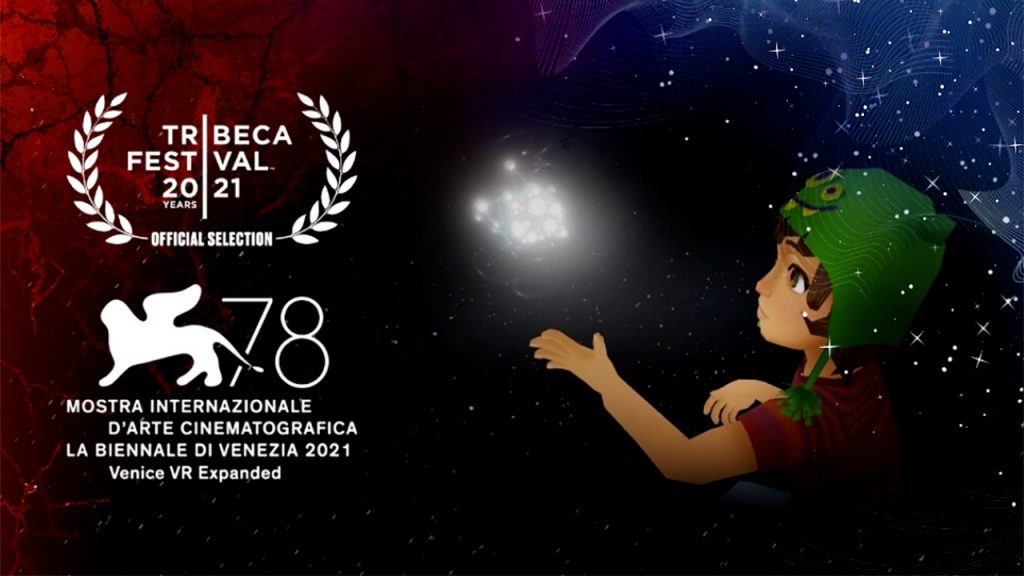
A. – You really did an incredible work with Welcome to Respite! What made you decide that VR was a good medium for it?
LYNDSIE SCOGGIN (Producer @ CoAct Productions & Creative Director, Performer) – The IRL version of Respite was such a beautiful experience, but there are many obstacles in sustaining a show designed for a single audience member. Additionally, the pandemic was leaving me unsure of when live entertainment would be feasible altogether. VR seemed like the perfect opportunity to challenge myself creatively, create something that could be participated in from the safety of our own homes, and share intimate immersive theatre on a platform that reaches audiences worldwide!
The IRL production relied so much on meaningful connections made between the participant and performer, something that couldn’t possibly work the same in VR. We knew though, that the platform could offer so many more possibilities. We ended up going through a transitioning phase, where we found out that we could make certain aspects of the show more magical or larger than life. For example: the use of scale or animations.
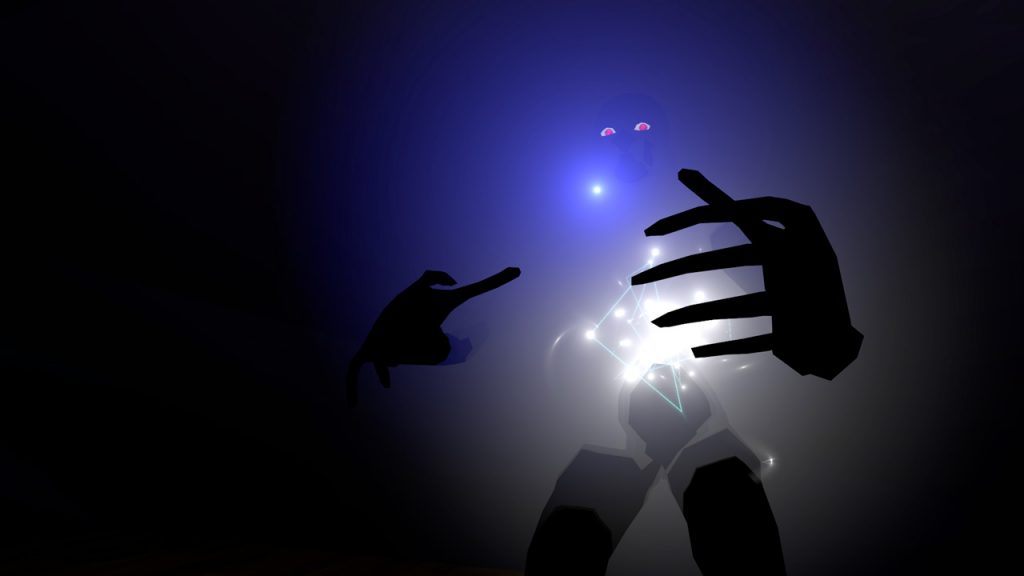
Immersivity: the role of comfort, diegesis and crowd control
A. – Sometimes it’s difficult to balance your need, as authors / writers / filmmakers, to tell a story that needs to reach a certain end and the user’s need to feel they have agency in it. How did you work on this in Respite? What tools did you use to hold the reins of the storytelling?
BRADEN ROY (Producer, VR Adaptation & Performer @ Ferryman Collective) – In many ways interactive storytelling is like performing a magic trick, guiding the audience’s gaze and direction in such a way that they feel in control and unaware of the artifices at work.
At its most basic level, our primary responsibility as storytellers is to strip away any hurdles which might impede our audience’s immersion and subtly replace them with the foundation of a new reality. You’d think the computer strapped to their face would be the biggest hindrance in immersing audiences in the world, but instead it’s the small details which make or break their sense of immersion and freedom. These can largely be broken down into three categories: comfort, diegesis and crowd control.
While many before us have helped pave the way for comfortable experiences within VR, establishing methodology and best practices, it’s still something which we need to be constantly mindful of during the design, development and playtesting phases.
How can we “transport” our audience member to another scene without causing motion sickness? Is there a way that we can implement an effects heavy scene so that the audience member not only feels grounded but also has a consistent framerate across all devices? What is the right balance between high fidelity assets which can approximate a real-world setting and optimized assets which allow for better performance? It’s always a tight-rope walk to establish the optimal compromise between comfort and grandeur, but doing so correctly sets the baseline which the next two categories hinge on.

Diegesis, in the context of interactive experiences, essentially means keeping the strings hidden and ensuring that the way the user interacts with the world and the things they experience within it adhere to the truths of the reality they’re presented. A common example of this is low health being communicated as a red overlay with accompanying heartbeat audio rather than a traditional UI in a FPS game. Welcome to Respite is about as far from a FPS as you can get, but the same principle remains. We need to communicate the means by which they interface with the world in subtle ways which are true to the reality we’re painting for them as well as providing logical constraints. This ensures we have our hands firmly on the reins of the larger narrative, while still allowing a sense of freedom and agency. Rather than relying on invisible walls, a door is in place and locked for narrative reasons. An attic door latch is out of reach until we need it as Alex, a seven-year-old child, cannot reach it. Using diegetic design throughout allows us to invisibly place rails to both organically guide the audience as well as maintain a cohesive narrative order in what might otherwise devolve into chaos.
While both comfort and diegesis lay the essential foundation for maintaining immersion and order, it’s truly the crowd work and control provided by our live cast which allows for not just the appearance of audience agency, but the real thing. They can both cater to and rein in the choices of the audience, call back to their earlier actions or even bypass scenes if the need arises. This is all, of course, done completely in character as Alex’s mom and dad. If the audience member is being unruly, they will scold them as would be appropriate for the parents of a seven-year-old child. The same is true for an infinite amount of potentially choices or behaviors on the part of the audience, with our cast intuitively responding and course correcting as necessary. All the while, they’re able to maintain a consistent overarching narrative with the audience being none the wiser. See? A magic trick.
Working with the different characters of “Welcome to Respite”
A. – Users can decide to be “alters” – invisible members of the audience who will serve as spectators of Alex’s experience – or to play Alex themselves. What can you tell us about these two different roles?
STEPHEN BUTCHKO (Producer & Performer @ Ferryman Collective) – The Alters represent alternate facets of Alex’s personality. Audience members who experience the show as an Alter are invisible and though the “role” is more of an observational one, the Alters have opportunities to help protect Alex in times of crisis. They also are free to explore their environment and learn information that is visible to only them.
The script was written with the understanding that the person playing Alex may be a professional actor or may not have any performing experience at all. All of the actors portraying the parents (Michael and Molly) have improv experience and are well-suited to adjusting their performance based on the level of interaction from a particular “Alex.” The more open and vulnerable that “Alex” allows them self to be, the more engaging the show is for everyone. We often don’t know what we are going to get with our “Alexs’,” which lends itself well to the DID aspect of the show. There is a special authenticity to the performances when Mom and Dad learn for the first time that their kid may not remember important periods in their life, etc., as Alex makes up the script on the spot. It can go anywhere and is a lot of fun to play out.
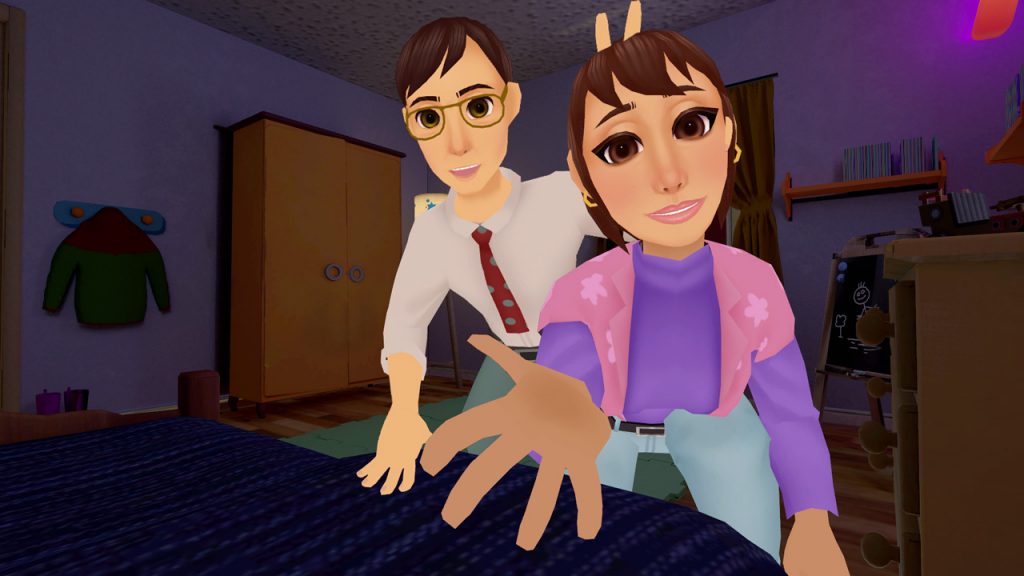
At its most basic level, our primary responsibility as storytellers is to strip away any hurdles which might impede our audience’s immersion and subtly replace them with the foundation of a new reality
Braden Roy (Producer, VR Adaptation and Performer @ Ferryman Collective)
A. – There are several pieces at 2021 VeniceVR Expanded that address the topic of mental illness in general. In Welcome to Respite, mental illness is not only something that Alex lives within themselves, but an almost physical presence. Can you tell us more about the visual and artistic choices you made to represent psychological dynamics in this story?
LYNDSIE SCOGGIN – Welcome to Respite takes place at a time in Alex’s life when they are first and unknowingly experiencing the symptoms of dissociative identity disorder. While alternate personalities (alters) don’t manifest as hallucinations in real life, we wanted the participants to really feel their presence. We are, after all, experiencing this memory in Alex’s subconscious mind.
Kyle, the Protector, is represented by a ball of light, feeling warm, welcoming and safe. The Shadow represents Alex’s Persecutor, or rather, the part of Alex that embodies the trauma. It appears to Alex as somewhat of a “monster in the closet”. Much like a child might imagine it: hiding and lurking, with its presence felt but not always seen. Its unsettling humanoid form symbolizes their abuser, but is indistinct as Alex has repressed these memories.
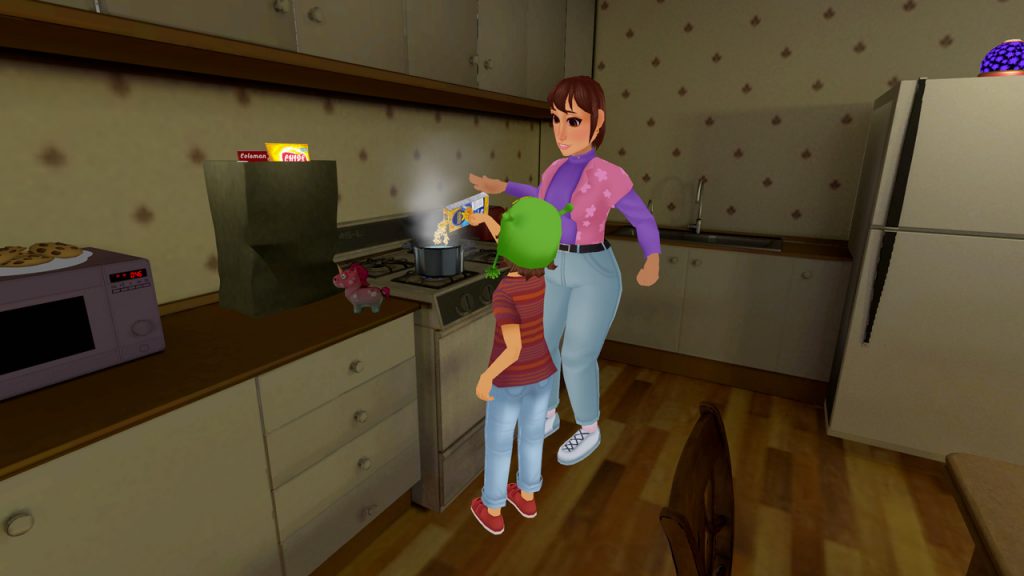
On the importance of inclusivity and how to build it
A. – Representation is a huge part of Respite. Alex doesn’t have a set gender, nor are they ethnically defined, and it’s left up to the user to decide who this character will be and what they will look like. Can you tell us more about this?
BRIAN TULL (Producer, VR World Builder @ Ferryman Collective) – Inclusivity was always a priority for us. Working in a medium where we’re given the power to decide what form the audience will take is a fundamental factor in shaping how they understand and interface with the world. This is particularly important in our show given that we’re quite literally giving them a perspective of the world most of us haven’t experienced in many years. Placing the audience into the role of a concrete, immutable character is a valid and powerful choice depending on the story you’re trying to tell but in Welcome to Respite, we’ve tried to maintain a balance of immersing guests in the unique experience of a child with DID while creating those universal connections by allowing Alex to represent who they are.
How we ultimately went about this was a result of months of internal discussion, experimentation, and consultation with others who have tackled this challenge in the past. The script was always written to be gender-inclusive so that wasn’t an obstacle, but we still had to contend with how to visually represent gender. The possibility of using distinct models for each gender was considered but we felt that would force people into a representation of themselves they didn’t identify with just to be the correct gender. We expressed these concerns to our very talented avatar creator, Sonnet Cooper, and he created a character whose appearance is focused on who they are as a person rather than representing any particular gender norms.
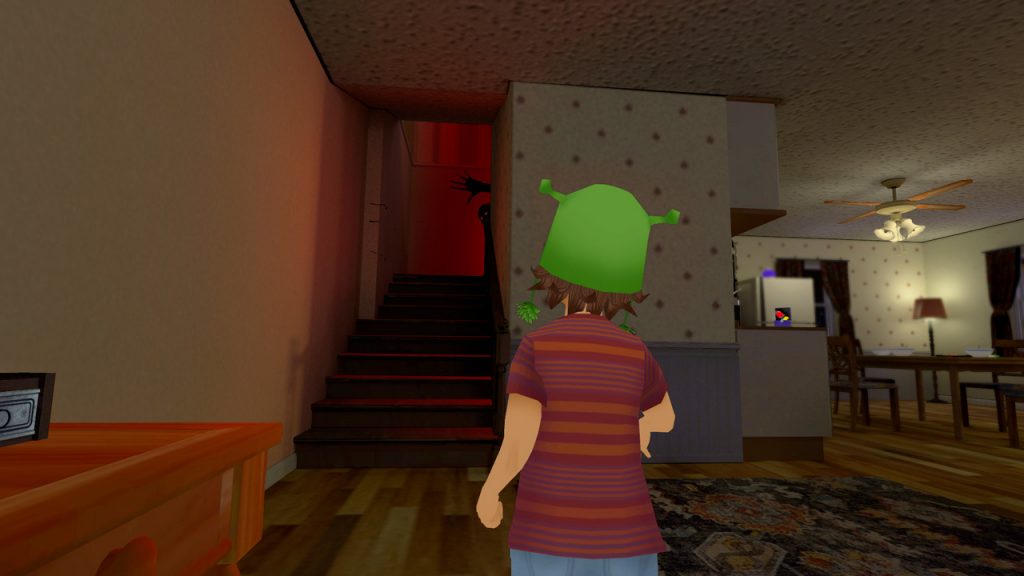
Tackling the issue of race was a challenge as Welcome to Respite is the story of a family and we can’t ask our actors to embody an ethnic or racial identity that isn’t their own any more than we can with Alex. Given that initial condition, our options were limited to making the guest have the same general skin color as our actors, making everyone a color not seen in humans, or allowing Alex to potentially not be the biological offspring of the parents. Forcing them into a specific skin tone didn’t work because it undermined the ability to represent themselves and trying to make the characters hues of blue and purple detracted from the warmth and familiarity of the setting so we ended up keeping things open-ended on the issue of Alex’s birth to allow for them to be any race.
Live performance in VR allows us to take the infinite potential and vitality of human interaction and heighten it with the freedoms afforded to us by the medium.
Brian Tull (Producer and VR World Builder @ Ferryman Collective)
Weaving technical problems into the narrative
A. – One of my fondest memories of the time I tried Welcome to Respite is the HUGE teddy bear that came to get me when there was a technical problem with the scene. Sure, it made me smile, but it was more than that: it indirectly gave me the feeling you were really trying to make every single detail as much a part of the story as possible. Even in the “bugs” I felt immersed! I need to ask: when emergencies like this happen, do you need to interrupt the narrative completely or have you found a way around it to somehow keep the story / the atmosphere / the immersion going?
WHITTON FRANK (PR, Performer @ Ferryman Collective) – I remember that show! I was playing the mom and we were having issues with the world. We actually have a whole chain of command going on behind the scenes for just such occasions, so when something goes wrong we always have other actors as well as a stage manager on standby.
We try as much as we can to keep the narrative and the immersion going. This is something that our creative director, Lyndsie, and many of our production team felt was important from the beginning. It is why you are greeted by the bear and a Playmobil man at the very start who instantly work to bring you back into a childlike state of mind. We want you to start feeling that sense of joy and wonder from the moment you enter Alex’s fort for onboarding.
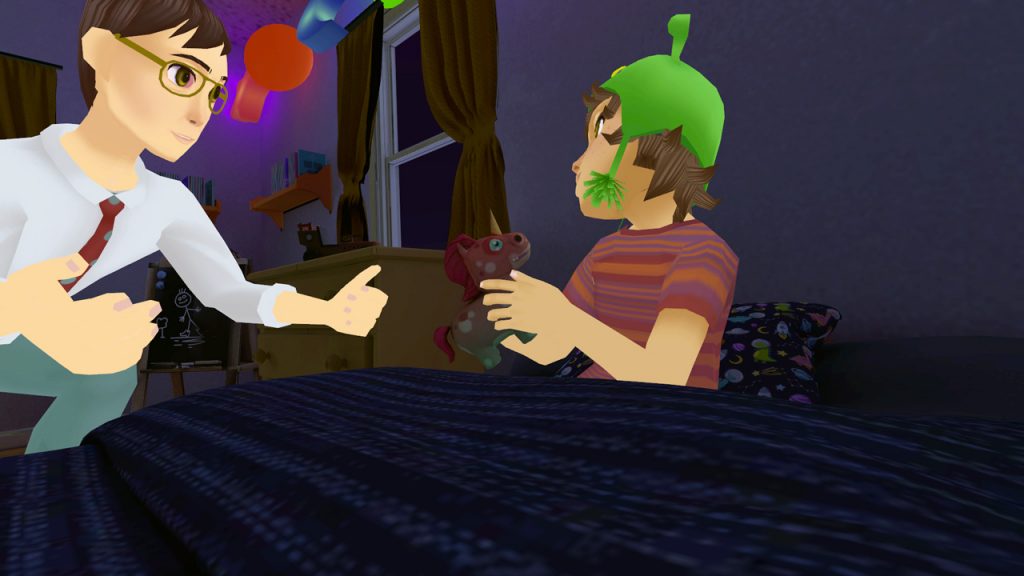
In order to prepare for things going wrong, we do a lot of testing and prep shows, so luckily we usually get to find the bugs before performing for audiences. Sometimes we can solve the problems and sometimes we have to come up with contingency plans and dialogue to keep the immersion going if the bug cannot be fixed. So, if the Alex is having connection issues, or we cannot hear them we will say things like “Oh Alex, you are being awfully quiet today, are you alright?” Or if they drop out of the world and are able to get back in, we weave that into the narrative with something like “Alex, it felt like you disappeared for a moment there.” Another example of this is that we occasionally have a bug where the Alex avatar will appear as a robot to other players and we still are not sure exactly why. To get around this issue we have our onboarding team state that sometimes the fort gets invaded by bad robots and we ask the players if they see any such robots.
We have tried to find creative and still immersive issues for any bugs we have encountered so far and it is definitely something that we work on and pay attention to. We try to make it so that the audience does not feel overwhelmed or upset that the tech is getting in the way of enjoying the show.
After the experience and into the world: “Welcome to Respite” as a theatre foyer
A. – When “Welcome to Respite” comes to an end, you don’t just leave the world, but find yourself in a place that don’t belong to the narrative but feel a bit like the foyer of a theatre would feel: a place to discuss what you’ve just seen, or meet other people for a drink. It’s a choice that made the experience more “complete” for me. Why did you make it?
SCREAMING COLOR (Special effects and Animation Designer, Performer, Co-Audio Director, Music @ Ferryman Collective) – We’re grateful that you viewed it that way, because that was exactly our intention- that the post-show credits room was different enough from the show itself that a bit of distance is created between the two, therefore allowing more “space” to reflect.
As for the stylistic inspiration for the design of the Credits Room, while it may appear at a glance to be completely incongruent from the aesthetic of the show, the concept is very on brand in two key ways. 1) From their alien hat, to all the decor in their bedroom, and of course the star projector scene in the attic, it becomes rather clear throughout the show that Alex has a passion for and connection with space. The sun here is the same sun we saw earlier in Alex’s imagination, but this time even larger than life. We wanted to drag out the feeling of childlike magic and wonder as long as possible. 2) The Credits Room was modeled by myself! (I also created the special effects, animations, and music for Welcome to Respite.) The design of the credits room is a very intentional reference to the aesthetic of my previous projects, Club Gumball & Gumball Lounge, both of which are also currently being featured at Venice!

On the future of live VR experiences
A. – Speaking of the future of these productions: where would you like to push the boundaries of immersive theatre and live VR experiences? Where do you see it going in a few years time?
BRIAN TULL – There are two equally important elements of live VR performance that excite me: creative freedom and commercial accessibility. The medium allows for so much that would be heinously expensive, prohibitively dangerous, or physically impossible outside of VR.
When you imagine something, you create a reality in your mind that is unbounded by scale or complexity; you may not have considered every detail but you know it’s there. When we make art, we take that unbounded idea and compress it to fit the limitations of the medium. This isn’t inherently a bad thing, creativity can spring from limitations but VR is the ideal platform for creating the most compelling translation of those imagined worlds. A compelling reality is about more than just a sense of presence, however, and the feeling of being transported to another place falls apart when you realize all of the inhabitants are little more than dolls that say a few canned phrases when you click on them. Live performance in VR allows us to take the infinite potential and vitality of human interaction and heighten it with the freedoms afforded to us by the medium.
Aside from the inherent limitations of in-person theatre in being able to faithfully convey everything we can imagine, you’re going to need a considerable budget to even get close. Not only does this impact how many shows get made but also the type of shows that get made. If a show doesn’t have mass appeal in the city it’s being shown in, it’s not going to be profitable and there may not be a market for theatre in that area. In having a global reach to everyone with a headset, VR allows for so many types of shows that would otherwise not see the light of day to find an audience. This includes stories from cultures that might be spread across the world and groups that might have a more niche interest that theatre hasn’t traditionally served.
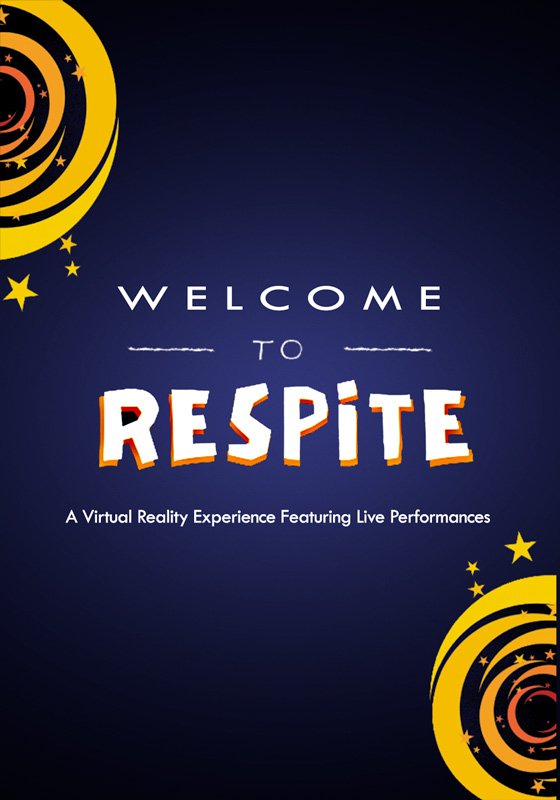
Accessibility is so, so important for sure. It’s an act of compassion, first of all, in wanting other people to enjoy the thing you’re created regardless whether they have means to buy a powerful PC, or only Mobile VR hardware like the Quest
Andy Aloisio (Programmer and VR Developer @ Ferryman Collective)
A final reflection on innovation and accessibility
A. – Some festivals are almost inaccessible to the “ordinary” audiences. They require you to have a cutting edge technology that few people have. One of the most significant characteristics of Welcome to Respite is how accessible it is. In this – in the way it uses an accessible technology to create something new – I recognize a great element of innovation. What’s your opinion about this? What do you think innovation is, today, in relation to XR and XR storytelling?
ANDY ALOISIO (Programmer, VR Developer @ Ferryman Collective) – Accessibility is so, so important for sure. It’s an act of compassion, first of all, in wanting other people to enjoy the thing you’re created regardless whether they have means to buy a powerful PC, or only Mobile VR hardware like the Quest.
That’s also true in another sense; that is wanting people who deal with motion sickness, colorblindness, social anxiety, neurological limitations, etc. to access your stuff. Working for accessibility also means that you respect your work in that you want it to be shared with other people. For us I think this is true of Respite but it’s also true of VR theater in general. We’re all helping create VR theater as a new medium and we love it enough that we want everyone to have access to it.
As far as innovation goes, for me personally, that’s the reason I show up. Being a programmer or software engineer is ultimately about creative problem-solving and nothing else. VR is new technology, and VR theater is even newer, and that means new problems to tackle. Accessibility is one of those problems, and so making VR experiences work for everyone has a natural sense of purpose, at least for me. Innovation for accessibility is really about a thousand little problems to solve in two areas: performance optimization, and onboarding.

Performance optimization because that’s the whole game for getting media to run on Mobile VR hardware; you have to really pinch pennies when it comes to how much graphical and computational processing you’re asking hardware to do. Creativity comes into this when you’re making decisions about the content, because it forces you to think “What is the effect we’re going for here, and how many different designs can we use to get that effect in the audience?” Then you ask “OK, which of these ways are expensive, and which are cheap, in terms of hardware processing?” In that way I’m sure it’s the same as real-life theater, where the expense you’re looking at is materials and labor.
Onboarding assumes that the audience knows very little about the medium they find themselves in, and asks “What is the shortest, most frictionless path to get them from where they are to the point where they know enough to function and enjoy this content?” The constraints here are just knowing how hard it is for people to learn quickly and pay attention, especially when they’re in “entertain me” mode and not “teach me” mode.
The app that really nailed onboarding is The Under Presents. In TUP, you go from first load-in to understanding the basic controls within minutes. No text, no voices, just a couple visual aids and a handful of simple obstacles. They have the advantage of having fairly simple controls, too. I marvel at the wisdom of their design decisions.
Personally, my rule # 1 is never to make people read (reading has second-language implications too). A live person explaining things to you is a good way to go, and that’s what we relied on most with Respite. Visual demonstrations are also very important; we used a common “point of interest” visual to try and clue people in to pay attention to specific points. There’s lots of room for innovation in getting people to pay attention to the right stuff during a live VR experience.
The Severance Theory: Welcome to Respite is a Virtual Reality experience featuring live theatrical performances created by CoAct Productions and co-produced by Ferryman Collective and CoAct Productions (find it on XRMust database here).
Tickets for performances will be available during the Venice Film Festival for accredited users (more info here). To be notified about future performances, visit The Severance Theory’s official website or follow their Facebook page at this link.



Leave a Reply
You must be logged in to post a comment.